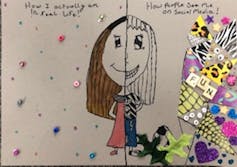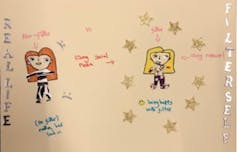How Beauty Filters Affect Tweens Using Social Media
TikTok’s new “bold glamour” filter “enhances” physical features in a way that makes it difficult to distinguish whether someone is using a filter or not, despite its airbrushing qualities.
Unlike its predecessors, this filter allows movement through an AI feature with the filter remaining fixed on when, for example, a hand crosses the face, with fewer glitches.
Users could be left comparing their unfiltered appearance with their “perfect” filtered self. They may start to develop unrealistic goals of perceived physical perfection that affect their self esteem.
Although the terms of service for most social media platforms require users to be at least 13, a significant number of “tweens” (children between the ages of nine and 12) now have a social media profile.
Online safety lessons in schools tend to concentrate on physical risk and predatory behaviour rather than emotional risks that children may encounter, as these may not be as apparent or experienced by adults.
The damaging effect of “filters” (digital image effects that alter a person’s appearance) is less commonly taught.
In my research, I presented eight focus groups with activities to generate discussions with children of 10 and 11 years of age who were in their final year of primary school. One of the activities was related to the use of filters.
Participants were given a set of photographs of people using filters on the social media site Snapchat and were asked questions such as: “How are these different from how they look in real life?” and “why do people use these filters?”
The results demonstrated a clear and distinct gender divide. The boys said they used filters for fun and entertainment, favouring dog ears and exaggerated tongues to “make people laugh”. The girls used filters to create an idealised image that conformed to beauty ideals and for validation in the form of likes and comments.

One girl, Samantha, said: “[filters] make you look perfect and flawless”. Another explained: “I like putting filters on because it doesn’t show my birthmark at all. It takes the blemishes off my face”.
Similarly, tween Mia explained: “when you put a filter on, it makes your skin tone better and it covers up any spots or like any bruises and stuff that you feel insecure about in yourself.”
My findings suggest that girls are internalising and aspiring to the beauty ideals that they are consuming via social media. There is a pressure to adopt a polished, physical appearance through filters, which may have emotional repercussions.
‘Beauty Isn’t Everything’
I also used collaging as an activity for exploring individual experiences. One child, Sophie, chose to show a binary depiction of herself as two halves.

Author provided, CC BY
On the social media side, she used lots of different animal prints in triangles to show that you can be lots of different things and there are lots of different parts of yourself.
She explained that the patterns she had chosen looked unnatural, unlike the more realistic filters online.
Because (like other females in the study) she felt that there is an expectation for girls to look a certain way, Sophie also wrote “no one is perfect” on her collage.

Author provided, CC BY
For the girls in my research, there was a sense that self expression was strongly linked to appearance, with a pressure to adhere to certain perceived physical ideals.
In her collage, Karen discussed at length how social media can be an augmented reality and can emphasise feelings of self consciousness linked to physical appearance.
The characters drawn on her collage show a “real-life” self that had no filter, which “makes her sad” and a “filter self” which used make up and filters to enhance her appearance and made her happy.
She also emphasised the feelings of negative self-esteem that viewing filtered images could have by saying:
People try and make themselves look beautiful and at the end it may really disappoint them.
Similar research from 2020 also concluded that girls tend to replicate “female” cues popularised through social media patterns, such as exaggerated lips and flawless skin.
Although my research specifically focused on Snapchat, other social media platforms such as TikTok and Instagram also encourage enhancing appearance through filters.
Beauty filters reinforce the message that wearing makeup, looking a certain way and conforming to beauty ideals, is the desired physical state for women. Isabel had a strong message for girls in her collage: “be your own person and stop comparing yourself to others”.
The widespread use of filters is certainly not facilitating this message and it is important that the emotional repercussions of using these appearance altering tools – as well as continually seeing them in social media feeds – is addressed.
Open discussions could help educate girls to learn that these unattainable physical aspirations do not represent reality.![]()
Written by Claire Pescott, Senior Lecturer in Education, University of South Wales for
![]()
This article is republished under a Creative Commons license. Read the original article.
Top image by Jessica Lewis Creative for Pexels
Second image by Christian Wiediger for Unsplash
More Girls That Create Posts
Help Your Girl Accept and Love Her Body With Body Positive Parenting

